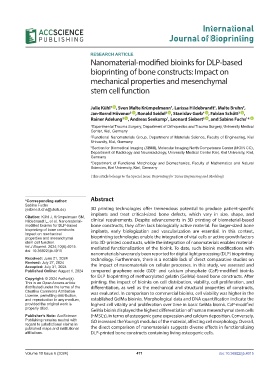Page 479 - IJB-10-6
P. 479
International
Journal of Bioprinting
RESEARCH ARTICLE
Nanomaterial-modified bioinks for DLP-based
bioprinting of bone constructs: Impact on
mechanical properties and mesenchymal
stem cell function
Julie Kühl 1 id , Sven Malte Krümpelmann , Larissa Hildebrandt , Malte Bruhn ,
2
1
1
Jan-Bernd Hövener 3 id , Ronald Seidel 3 id , Stanislav Gorb 4 id , Fabian Schütt 2 id ,
Rainer Adelung 2 id , Andreas Seekamp , Leonard Siebert 2 id , and Sabine Fuchs *
1
1 id
1 Experimental Trauma Surgery, Department of Orthopedics and Trauma Surgery, University Medical
Center, Kiel, Germany
2 Functional Nanomaterials Group, Department of Materials Science, Faculty of Engineering, Kiel
University, Kiel, Germany
3
Section for Biomedical Imaging (SBMI), Molecular Imaging North Competence Center (MOIN CC),
Department of Radiology and Neuroradiology, University Medical Center Kiel, Kiel University, Kiel,
Germany
4 Department of Functional Morphology and Biomechanics, Faculty of Mathematics and Natural
Sciences, Kiel University, Kiel, Germany
(This article belongs to the Special Issue: Bioprinting for Tissue Engineering and Modeling)
Abstract
*Corresponding author:
Sabine Fuchs
(sabine.fuchs@uksh.de) 3D printing technologies offer tremendous potential to produce patient-specific
implants and treat critical-sized bone defects, which vary in size, shape, and
Citation: Kühl J, Krümpelmann SM,
Hildebrandt L, et al. Nanomaterial- clinical requirements. Despite advancements in 3D printing of biomaterial-based
modified bioinks for DLP-based bone constructs, they often lack biologically active material. For larger-sized bone
bioprinting of bone constructs: implants, early biologization and vascularization are essential. In this context,
Impact on mechanical
properties and mesenchymal bioprinting technologies enable the integration of vital cells or active growth factors
stem cell function. into 3D-printed constructs, while the integration of nanomaterials enables material-
Int J Bioprint. 2024;10(6):4015. mediated functionalization of the bioink. To date, such bioink modifications with
doi: 10.36922/ijb.4015
nanomaterials have rarely been reported for digital light processing (DLP) bioprinting
Received: June 21, 2024 technology. Furthermore, there is a notable lack of direct comparative studies on
Revised: July 27, 2024
Accepted: July 31, 2024 the impact of nanomaterials on cellular processes. In this study, we assessed and
Published Online: August 1, 2024 compared graphene oxide (GO)- and calcium phosphate (CaP)-modified bioinks
for DLP bioprinting of methacrylated gelatin (GelMa)-based bone constructs. After
Copyright: © 2024 Author(s).
This is an Open Access article printing, the impact of bioinks on cell distribution, viability, cell proliferation, and
distributed under the terms of the differentiation, as well as the mechanical and structural properties of constructs,
Creative Commons Attribution was evaluated. In comparison to commercial bioinks, cell viability was higher in the
License, permitting distribution,
and reproduction in any medium, established GelMa bioinks. Morphological data and DNA quantification indicate the
provided the original work is highest cell vitality and proliferation over time in basic GelMa bioink. CaP-modified
properly cited. GelMa bioink displayed the highest differentiation of human mesenchymal stem cells
Publisher’s Note: AccScience (hMSCs), in terms of osteogenic gene expression and calcium deposition. Conversely,
Publishing remains neutral with GO increased the Young’s modulus of the material, affecting cell morphology. Overall,
regard to jurisdictional claims in
published maps and institutional the direct comparison of nanomaterials suggests diverse effects in functionalizing
affiliations. DLP-printed bone constructs containing living osteogenic cells.
Volume 10 Issue 6 (2024) 471 doi: 10.36922/ijb.4015

